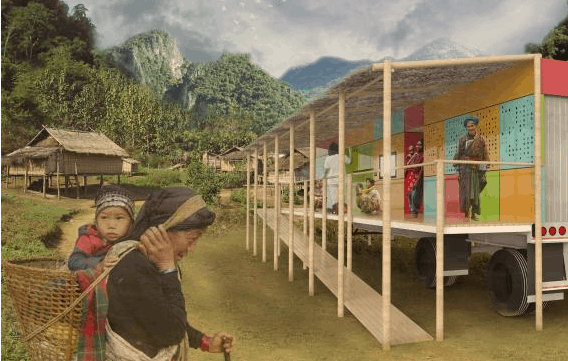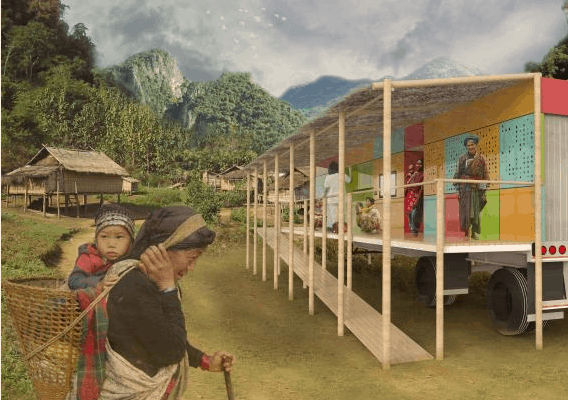Blog
Article Highlight: Think Global, Design Mobile

The featured article below was first published in Healthcare Design Magazine. It was edited by Anne, DiNardo. It may be seen here.
Summary: A winning clinic design inspires ideas on how to deliver healthcare, education, and community to the globe’s hardest-to-reach populations.

The winning professional design features a prefabricated core that opens up to reveal circulation space and bold colors, which are used to differentiate areas. Credit: Patrick Morgan
Last summer, Building Trust International, a Brighton, England-based nonprofit that uses design to address global issues, was constructing a new medical dispensary for a rapidly growing diabetic population in Siem Reap, Cambodia—a project that inspired its leaders to see mobile health clinics as a way to improve access to care for some of the most densely populated and poorest parts of the planet.
“Access to healthcare is one of the contributing factors to rapid urbanization pushing infrastructure to the limit,” says David Cole, the organization’s director and co-founder. “People are forced to leave rural areas to get access to drugs and medical care, living in slums and informal settlements of urban centers.”
Throughout Southeast Asia, Cole says, many healthcare providers lack the funding to buy land and invest in infrastructure, so they rent temporary residential accommodations and adapt them for medical purposes. But these properties aren’t designed with healthcare services in mind, so they lack important elements, such as proper lighting. In addition, spaces are often subdivided in ways that allow for cross contamination.
The issue inspired Building Trust International to launch its Moved to Care design challenge in December 2013, focusing on solving these challenges in Southeast Asia. The project required designers to create a clean, sterile environment for small surgical procedures; a temperature-controlled space for storing medicinal drugs; and basic wash, toilet, and kitchen facilities. Entries also needed to be sensitive to the tropical surroundings and provide sustainable solutions where possible.
A multidisciplinary team from the U.S., including Patrick Morgan, a designer at Interface Studio Architects (Philadelphia), his brother Simon Morgan, an associate at a health policy research firm in New York City, and Jhanéa Williams, a design architect at Sasaki Associates Inc., (Watertown, Mass.), took home top honors in the professional category with a prefabricated mobile clinic design that’s 538 square feet and expands to 1,614 square feet when side decks are deployed.

The design allows for some of the interventions to take place outside of the clinical area, such as preventive medicine, nutritional education, and healthy lifestyle lessons. Credit: Patrick Morgan
Circulation spaces on the exterior of the unit can be used as waiting rooms on busy days as well as places to host educational seminars. “By pushing the circulation to the exterior of the project, it makes the project more open but it also reduces the transmission of disease,” says Simon Morgan.
An enclosed exam room is equipped to handle a range of medical needs, and a sterile treatment room allows for minor surgeries and injuries.

A cut-through diagram of the winning project shows the mobile unit when it’s fully expanded. Credit: Patrick Morgan
The proposed materials palette includes recycled aluminum panels, which would withstand the humid climate, and semitransparent polycarbonate panel walls that both transmit and shade sunlight due to their ribbed design. Using a trailer as the building base keeps the clinic elevated above potential rising waters, and a rooftop solar array can be used to power medical equipment and refrigeration for medicines.
The project team says the biggest design challenges were being mindful of limited building resources and materials, designing a low-tech facility that would perform well in extreme climates and weather conditions, and ensuring that design aspects could be adapted to the local vernacular.
While the project was designed with Southeast Asia’s environmental conditions and populations in mind, the team says there’s a universal lesson, as well. “Don’t shut the door to the community,” Simon Morgan says. “By building a facility that invites local participation and encourages the community to utilize the services and educational opportunities provided, we’re able to reach a much broader audience.”
Going forward, Building Trust International says it has partners in Africa and Southeast Asia that are interested in developing the winning mobile clinic design and is working on establishing relationships with manufacturers.
“As with all humanitarian aid projects, funding is an issue,” Cole says. “However, through showing that long-lasting sustainable solutions can only be achieved with the mobile healthcare units, we hope the impact of the project will be as far-reaching as it should be.”
Article Source: DiNardo, Anne. “Think Global, Design Mobile.” Healthcare Design. Vendome Group, LLC. 2014.







